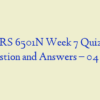Description
NURS 6501N Week 1 Quiz with Answers
- A 55-year-old male with a 30-year history of smoking is examined for respiratory disturbance. Examination of his airway (bronchial) reveals that stratified squamous epithelial cells have replaced the normal columnar ciliated cells. This type of cellular adaptation is called:
- What principle should the nurse remember when trying to distinguish aging from diseases?3. Which of the following mutations have the most significant effect on protein synthesis?
- A eukaryotic cell is undergoing DNA replication. In which region of the cell would most of the genetic information be contained?
- When a patient asks what causes cystic fibrosis, how should the nurse respond? Cystic fibrosis is caused by an _____ gene.
- The ion transporter that moves Na + and Ca 2+ simultaneously in the same direction is an example of which of the following types of transport?
- In teaching a patient with cirrhosis, which information should the nurse include regarding cholesterol?
- What is the role of cytokines in cell reproduction?
- A nurse is discussing the movement of fluid across the arterial end of capillary membranes into the interstitial fluid surrounding the capillary. Which process of fluid movement is the nurse describing?
- The early dilation (swelling) of the cell’s endoplasmic reticulum results in:
- Sodium and water accumulation in an injured cell are a direct result of:
- A group of prison inmates developed tuberculosis following exposure to an infected inmate. On examination, tissues were soft and granular (like clumped cheese). Which of the following is the most likely cause?
- A 50-year-old male was recently diagnosed with Huntington disease. Transmission of this disease is associated with:
- A patient who has diarrhea receives a hypertonic saline solution intravenously to replace the sodium and chloride lost in the stool. What effect will this fluid replacement have on cells?
- A nurse is reviewing the pedigree chart. When checking for a proband, what is the nurse looking for?
- A newborn male is diagnosed with albinism based on skin, eye, and hair appearance. Which finding will support this diagnosis?
- A nurse is reading a chart and sees the term oncotic pressure. The nurse recalls that oncotic pressure (colloid osmotic pressure) is determined by:
- A 12-year-old male is diagnosed with Klinefelter syndrome. His karyotype would reveal which of the following?
- What causes the rapid change in the resting membrane potential that initiates an action potential?
- A patient has severe mental retardation caused by a deletion of part of chromosome 5. What genetic disorder will the nurse see documented in the chart?
- The student is reviewing functions of the cell. The student would be correct in identifying the primary function of the nerve cell as:
- An aide asks the nurse why people who have neurofibromatosis will show varying degrees of the disease. Which genetic principle should the nurse explain to the aide?
- A patient has a heart attack that leads to progressive cell injury that causes cell death with severe cell swelling and breakdown of organelles. What term would the nurse use to define this process?
- A nurse is teaching a patient with diabetes how glucose is transported from the blood to the cell. What type of transport system should the nurse discuss with the patient?
- A patient wants to know the risk factors for Down syndrome. What is the nurse’s best response?









